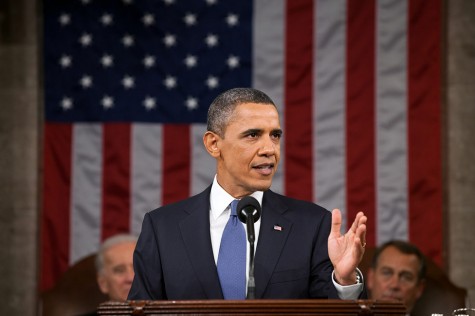State of the Union sets the stage for 2015
January 22, 2015

The State of the Union address is considered the most important annual speech in the United States government. It is in this monumental discourse that the President lays out his plans and aspirations for the year ahead, advocating his own political agenda on both domestic and international affairs to set the tone for the next twelve months.
On Jan. 20, President Barack Obama delivered his seventh and penultimate State of the Union before the viewers in the packed Capitol and the millions of Americans tuned in on television. According to CNN, the President was interrupted 80 times by applause and won over social media with a jibe about his election victories. Despite all of this, the jury is still out on if the State of the Union truly was a success.
Obama already has to face many new obstacles. For the first time in his presidency, both houses of Congress will be controlled by the Republican party. Back in the November midterms, the Democrats took another shellacking, ceding an even greater majority in the House while also losing their majority in the Senate, creating a truly divided government. With all of the 114th Congress now under Republican control, any leftist drafts for the President’s legislative agenda took a serious hit, and many wondered if we were headed to gridlock yet again.
The State of the Union was to be President Obama’s first major chance to show his hand before 2015 began. Having already caused major controversy and angered the GOP with his executive order on immigration in November, many were wondering if the White House would put forth a more moderate agenda to try and foster bipartisanship or continue with its liberal target. With the 2016 presidential election looming, 2015 would be last year for Obama to really push his ideas to build his legacy, making the decision all the more crucial.
Nobody can deny that the speech opened with aplomb. “The shadow of crisis has passed, and the State of the Union is strong,” declared an impassioned Barack Obama, drawing a standing ovation. From there, the president’s plan unfolded.
Obama pulled out all the stops: anecdotes about newlyweds Rebekah and Ben, an emboldened push for space exploration, a jab at Republicans about him winning two presidential elections and a mantra about creating a “better politics”. Pundits lauded the president’s confidence, saying we were witnessing the return of 2008’s Obama, the great orator that had taken the country by storm. More than just his confidence, however, analysts pointed to the agenda he put forth; more liberal than ever, as if there was no conservative Congress standing in his way.
Obama touched on a number of his major initiatives in the works: a $3,000 childcare tax credit for low-income families, pay equity for women, paid sick-leave and free community college were the main embodiments of his strategy of middle-class economics that felt like a slap in the face to a Republican Congress that would hardly consider said proposals. He offered a few olive branches to the GOP by suggesting new cyber-security laws and lauding free trade, but went right back to pumping out the liberal rhetoric with a plan for veiled capital gains tax increases and a stricter tax code on wealthy corporations. President Obama also talked up his willingness to use military might against terrorists and his belief in diplomacy and sanctions against the likes of Iran and Russia, putting the icing on the cake with his talks on Cuba.
The middle-class economics section of the speech particularly irked the establishment right. Despite new Senate Majority Leader Mitch McConnell urging that his chamber would seek to implement tax cuts and heavily reduce government spending, Obama was unequivocally clear in his resolve to increase taxes on the wealthy in order to give tax cuts to poor families and augment the minimum wage. One of his most leftist suggestions, making two-year community colleges free, has practically zero chance of clearing the Capitol, but the president trumpeted it nonetheless.
The Republican response, coming from freshman Iowa Senator and Tea Party favorite Joni Ernst, expressed the party’s determination to not let the majority of the president’s suggestions pass into law and to continue to fight his executive action on immigration and his now infamous Affordable Care Act, now branded Obamacare. This was a hint at the gridlock Americans may face over the next twelve months, only exacerbated by Obama’s persistent veto threats against any legislation that may undo his previous work in healthcare, the Keystone XL pipeline and more. However, with the onus on the Republicans to not just stop Obama but prove they can govern, the pressure could force the GOP to compromise in order to pass bills.
While the State of the Union was undoubtedly a brilliantly delivered oration, questions still remain on the speech’s effectiveness. With the economy on the up and the latest Gallup polls showing the president’s approval rating to be over 50 percent for the first time in half a decade and sure to increase after the address, Obama certainly has the political clout to make some moves.
Whether the Republican Congress and Democratic White House spend the next twelve months blocking each other’s initiatives or fostering bipartisan legislation is yet to be seen. For now, President Obama’s agenda has been put forth, and 2015 is set to unfold in a firestorm of factional bickering, crafty politics and, goodness forbid, some cohesive governing.






